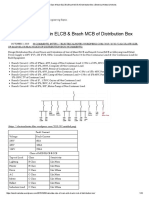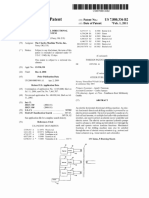26 00 00 - Electrical General: Design & Construction Standards, Revised January 2013 26.00.00-1
26 00 00 - Electrical General: Design & Construction Standards, Revised January 2013 26.00.00-1
Uploaded by
rediCopyright:
Available Formats
26 00 00 - Electrical General: Design & Construction Standards, Revised January 2013 26.00.00-1
26 00 00 - Electrical General: Design & Construction Standards, Revised January 2013 26.00.00-1
Uploaded by
rediOriginal Description:
Original Title
Copyright
Available Formats
Share this document
Did you find this document useful?
Is this content inappropriate?
Copyright:
Available Formats
26 00 00 - Electrical General: Design & Construction Standards, Revised January 2013 26.00.00-1
26 00 00 - Electrical General: Design & Construction Standards, Revised January 2013 26.00.00-1
Uploaded by
rediCopyright:
Available Formats
26 00 00 – ELECTRICAL GENERAL
DESIGN AND CONSTRUCTION STANDARD
PART 1: GENERAL
1.01 Electrical/Telecommunications Design
A. This section of the design and construction standard outlines general requirements for
electrical and telecommunications designs to be performed for the University of Texas at
Austin. This standard is intended to provide useful information to the Professional
Service Provider (PSP) to establish a basis of design. The responsibility of the engineer is
to apply the principles of this section and the ones that follow such that the University
may achieve a level of quality and consistency in the design and construction of their
facilities.
1.02 Electrical Space Planning Guide
A. The following requirements are to be used by architects for electrical space planning
considerations at the conceptual design level. Refinements and modifications will be
considered upon evaluation of the specific requirements in the building, but as a
minimum, allow space according the following guidelines:
1. Main Service Entrance room shall provide for adequate equipment and maintenance
clearance. Provide outside equipment access to this room.
2. Electrical rooms shall be centrally located and “stacked” so that feeder conduits and
bus duct are run as straight and short as possible.
3. Doors shall swing out where possible and as required by the National Electrical Code
(NEC).
4. Electrical rooms shall not share space with storage, telecommunications, janitor’s
sink, and piping.
5. If possible locate electric rooms away from outside walls, elevator shafts, stairwells,
HVAC duct chases, trunk runs, and other Utility Avenues so that branch circuits can
fan out in all directions.
6. Locate electrical room where it is not susceptible to flood from heavy rains, broken
pipes, stopped drains, or fire hose deluge.
7. Provide a separate space in the building for storage of spare lamps.
1.03 Polychlorinated Biphenyl (PCB) Remediation
A. This section provides general guidance concerning the specific preferences of The
University for abatement or removal of polychlorinated biphenyl (PCB) within buildings.
B. Reference Standards: Texas Hazard Communication Act chapter 502 of the Texas Health
and Safety Code. Volume 40-Code of Federal Regulations, Chapter 761.
C. General Requirements:
Design & Construction Standards, Revised January 2013 26.00.00-1
26 00 00 – ELECTRICAL GENERAL
DESIGN AND CONSTRUCTION STANDARD
1. Bulbs: Fluorescent light bulbs contain mercury. These bulbs must be handled
carefully so that they don’t break, packaged in approved boxes furnished by EH&S,
and given to EH&S for disposal.
2. Ballasts: Fluorescent lamp ballasts shall be treated as PCB waste unless labeled “no
PCBs.” PCB waste is regulated and must be packaged in drums furnished by EH&S,
and given to EH&S for disposal.
3. Fixtures: Fixtures and ballasts labeled “no-PCBs” will be disposed of by contractor in
accordance with any applicable regulations.
PART 2: PRODUCTS
2.01 Electrical/Telecommunications Design
A. All products used and specified in Division 26 and 27 must be UL approved and must
meet all applicable ANSI, NFPA, IEEE, EIA/TIA standards as indicated in the
appropriate sections of this design standard.
PART 3: EXECUTION
3.01 Electrical/Telecommunications Design
A. In addition to the specific requirements of the sections of the standard that follow, use the
following as baseline programming guidelines.
B. A typical Division 26 design project for the University shall include, but not be limited to
the design and specifications for the following items:
1. Electrical and Telecommunications Ductbank Design. Ductbank will be installed
from the University specified manholes to the building electrical and
telecommunications service entrance.
2. Main Electrical Service Entrance Equipment: Double ended unit substation.
3. Building Electrical Distribution Design: Normal and Emergency.
4. Special Systems Design: Including Fire Alarm and Security.
5. Telecommunication Systems Design: Performed by a registered telecommunication
designer.
C. Main Electrical Service Entrance Equipment:
1. As a part of the project cost, the Owner will provide and terminate the necessary (15kV rated)
cables from the designated manhole to the main service entrance equipment.
2. The main service entrance equipment shall be a double-ended unit substation configured according
to the attached one-line diagram.
D. Building Electrical Distribution Design:
1. The low voltage distribution system shall be separately derived 3 phase, 4 wire 277/480 volt
system supplying power to all fluorescent and HID lighting, all 480 volt utilization equipment and all
Design & Construction Standards, Revised January 2013 26.00.00-2
26 00 00 – ELECTRICAL GENERAL
DESIGN AND CONSTRUCTION STANDARD
motors over 7 1/2 hp. From the 480 volt distribution system, a separately derived 3 phase, 4 wire
120/208 volt system will be used to supply power to all incandescent lighting and miscellaneous
building power and receptacle circuits.
2. Provide at least one circuit for each classroom and do not connect more than one classroom on a
circuit.
3. All large electrical equipment, e.g. transformers and main switchgear shall be located at or near
ground level in the building near the power service entrance such that it may be removed if necessary
without dismantling
4. There shall be a complete grounding system with ground bars in each electrical room with
distribution equipment or transformers and ground wires with each circuit.
E. Coordination Issues
1. It is the responsibility of the engineering team to prepare Reflected Ceiling Plans that accurately
locate and coordinate ceiling panels, lighting fixtures, A/C supply and return grilles, sound system
speakers, automatic sprinkler heads, fire and smoke detectors, access doors, and any other ceiling
located items.
2. The final drawings shall as a minimum be checked for the following:
a. Physical space above ceiling for duct work, lighting fixtures, piping, etc.
b. That no piping of any type encroaches on electrical switchgear.
c. That electric closets are “stacked” so that feeder conduits and bus duct are in as straight a line and
as short a route as possible.
d. That electric closets are not next to elevator shafts or stair wells, vertical HVAC duct chases and
horizontal trunk runs or other Utility Avenues, etc., so that branch circuit conduits can “fan out” in
all directions. Do not locate on exterior walls.
e. That electric panels or terminal boards are not in Janitor’s closets or public areas.
F. Basic Drawing Requirements
1. Electrical, Special Systems and Telecommunications Drawings should be drawn on
1/8” = 1’0” scale or larger floor plans. In conjunction with the requirements listed in
sections of Division 26 that follow, the Electrical Drawings should include the
following information:
a. The location of all electric utilization, power distribution and special systems
equipment.
b. All branch circuit and feeder wiring including circuit numbers and circuit
schedule.
c. An overall electrical one-line diagram.
d. Complete riser diagrams for power and special systems.
Design & Construction Standards, Revised January 2013 26.00.00-3
26 00 00 – ELECTRICAL GENERAL
DESIGN AND CONSTRUCTION STANDARD
e. Detailed lighting fixture schedule including the type designation, manufacturer
product number, type and size of lamps per fixture, and the accessories and
methods for mounting the type of fixture
f. Detailed panel schedule for each panelboard, switchboard, motor control center,
etc. Include breaker, fusible switch size or fuse size, frame size, usage of circuit,
spares, spaces and connected load for each circuit.
g. Site plan where necessary showing electrical and telephone service entry, duct
bank and manhole locations and details, exterior lighting, circuiting, and details.
h. Grounding plan.
2. 1/4” = 1’0” scale drawings should be provided for the following:
a. Typical Rooms.
b. Electrical vaults and main power distribution areas.
c. Kitchens and other areas with high density of utilization equipment.
3. Separate drawings should be provided for lighting, power, special systems, and
telecommunications of each floor and roof.
4. Room names and numbers shall appear on all Electrical Floor Plans. Special systems
floor plans will require door numbers as well.
5. Column lines and designations, plan North, and graphic scale shall appear on all
sheets as they shall appear on all Architectural Sheets. All drawings shall be dated
and signed for each Review Submittal.
G. Specification Requirements
1. Electrical and Telecommunications Specifications shall be complete and in the CSI
Masterspec format. Specifications shall be tailored to the project and not contain
items that are not a part of the project.
2. Electrical Specifications should not instruct the contractor or installer to size a piece
of electrical equipment according to the National Electrical Code. All electrical
designs should be complete and appear as such on the Drawings and Specifications.
3. A clear statement shall be made concerning construction power; where available, and
at what voltage and phase, who makes and removes the installation, and who pays for
the energy.
4. Specify non-proprietary equipment. Specify products with proven reliability. Include
at least three manufacturers for all equipment.
5. Utility Specifications
K. Design Review
1. Schematic design review (3% overall) shall include:
a. Narrative description of services: electrical, communications, central clock
control, FCMS, CCTV, etc.
Design & Construction Standards, Revised January 2013 26.00.00-4
26 00 00 – ELECTRICAL GENERAL
DESIGN AND CONSTRUCTION STANDARD
b. Narrative description of electrical distribution, utilization voltages, lighting types,
illumination levels.
c. Rudimentary site plan with scale.
d. Basic floor layouts.
2. Preliminary Design Review or DD (15% overall) shall include:
a. Site plan showing services.
b. Major electrical routing and equipment on background sheets (floor plans) with
scale, North arrow, a column lines.
c. Typical lighting layouts for several representative areas.
d. Rudimentary one-line diagram.
e. Preliminary design presentation.
f. Special requirements, e.g., grounding, floor duct, plug mold, etc.
g. Rough draft of specifications.
h. Preliminary stage is subject to change and must yield to HVAC Utility routing.
3. Interim Design Review (60% overall) shall include:
a. Switchgear and panels located and drawn to approximate scales.
b. Lighting layouts including panels.
c. Several representative lights and receptacles circuited.
d. Fixture schedule.
e. Electrical symbols.
f. Site plan, all services detailed.
g. Panel schedules near completion.
h. Conduits larger than 2” size.
i. Bus duct and cable trays.
j. Controls.
k. Details.
l. One-line-diagram complete, except sizing of protective devices, transformers and
feeders for final horsepower selections.
m. Reflected ceiling plans.
n. Specifications of all major equipment.
4. Final Design Review (100% overall) shall include:
a. Design complete except for corrections required from Final Review Comments.
b. Engineer’s seal on all of the drawings.
END OF STANDARD
Design & Construction Standards, Revised January 2013 26.00.00-5
5.26.00 – ELECTRICAL GENERAL
DESIGN AND CONSTRUCTION STANDARD
Design & Construction Standards, Revised January 2013 6.26.00-6
You might also like
- Concept Design ReportDocument25 pagesConcept Design ReportSayed Nagy100% (5)
- Engineering Utilities Module 3Document85 pagesEngineering Utilities Module 3Neerom BaldemoroNo ratings yet
- Electrical Specifications PDFDocument134 pagesElectrical Specifications PDFscoodivNo ratings yet
- EIM 11 - Q3 Module 2Document6 pagesEIM 11 - Q3 Module 2Wilbert EleccionNo ratings yet
- 2.9 Electrical Systems 2.9.1 General Considerations General Guidelines IntentDocument8 pages2.9 Electrical Systems 2.9.1 General Considerations General Guidelines IntentRodrigo BabijisNo ratings yet
- +struc Specs (Addendum) - BiddingDocument7 pages+struc Specs (Addendum) - Biddingcmg3synctowerNo ratings yet
- Module 3Document4 pagesModule 3Mary Joy SalapiNo ratings yet
- Electrical ItemsDocument18 pagesElectrical Itemssaibalaji8009No ratings yet
- How To Draft Electrical PlansDocument43 pagesHow To Draft Electrical PlansMonique Oruga100% (2)
- Electrical SpecificationDocument266 pagesElectrical SpecificationMohamed AlasfarNo ratings yet
- Grounding and Bonding For Electrical Systems-Rev01Document11 pagesGrounding and Bonding For Electrical Systems-Rev01Mohamed Hamed100% (2)
- Information Sheet 1.3-3 Architectural Working DrawingsDocument6 pagesInformation Sheet 1.3-3 Architectural Working DrawingsNico C GutierrezNo ratings yet
- SPC - 01 - Sec-260526 - Grounding and Bonding For Electrical SystemsDocument9 pagesSPC - 01 - Sec-260526 - Grounding and Bonding For Electrical Systemsfouadelshabrawy71No ratings yet
- Electrical Installation Design: Terminology and DefinitionsDocument27 pagesElectrical Installation Design: Terminology and DefinitionsMirkena kebede100% (1)
- SPC - 01 - Sec-265600 - Exterior LightingDocument24 pagesSPC - 01 - Sec-265600 - Exterior Lightingfouadelshabrawy71No ratings yet
- Esd - Midterm - Cabrales PDFDocument8 pagesEsd - Midterm - Cabrales PDFPercival Cylas CabralesNo ratings yet
- UGA PPD Electrical Design Standards and Guidelines.Document5 pagesUGA PPD Electrical Design Standards and Guidelines.uddinnadeemNo ratings yet
- Technical Specifications - Cable LayingDocument48 pagesTechnical Specifications - Cable LayingShkelzen GoxhajNo ratings yet
- Chapter Three: Design of Installation SystemsDocument15 pagesChapter Three: Design of Installation SystemsNama DesalewNo ratings yet
- ELECTRICALDocument12 pagesELECTRICALKurt Darryl SabelloNo ratings yet
- Electrical InstallationDocument28 pagesElectrical Installationyonas abebeNo ratings yet
- Electrical TW GuidelinesDocument18 pagesElectrical TW GuidelinesValerie Shepard100% (1)
- 26 2416 PanelboardsDocument10 pages26 2416 PanelboardsMena Amir KhairyNo ratings yet
- 26 05 35 Electrical Gutters and WirewaysDocument4 pages26 05 35 Electrical Gutters and WirewaysAritra DasguptaNo ratings yet
- 5electrical Design Considerations EditedDocument40 pages5electrical Design Considerations EditedCamille SalmasanNo ratings yet
- Stantard ReviewerDocument19 pagesStantard ReviewercatherinejeanasNo ratings yet
- Specification-VI: PlcsupvaDocument7 pagesSpecification-VI: PlcsupvaSumit SharmaNo ratings yet
- Electrical Plan - Clarence HernandezDocument47 pagesElectrical Plan - Clarence HernandezClarence Hernandez100% (1)
- Va 26 24 16Document6 pagesVa 26 24 16adrian karl bonaNo ratings yet
- Specs For Lighting SystemDocument8 pagesSpecs For Lighting SystemEloy NateNo ratings yet
- Sample Tor ElectricalDocument2 pagesSample Tor ElectricalAlyza Caszy UmayatNo ratings yet
- Division 16 SampleDocument170 pagesDivision 16 SampleRodrigue BarbarNo ratings yet
- 494107293Document4 pages494107293Billy BrownNo ratings yet
- Installation of Lighting System Fans and ReceptaclesDocument6 pagesInstallation of Lighting System Fans and Receptaclesapparao42No ratings yet
- 460122588-7-REQUIRED-PARTS-OF-A-STANDARD-ELECTRICAL-PLANDocument25 pages460122588-7-REQUIRED-PARTS-OF-A-STANDARD-ELECTRICAL-PLANEduardo DavinNo ratings yet
- SPC - 01 - Sec-260519 - Low Voltage Electrical Power Conductors and CablesDocument11 pagesSPC - 01 - Sec-260519 - Low Voltage Electrical Power Conductors and Cablesfouadelshabrawy71No ratings yet
- Engineering Utilities Midterm NotesDocument4 pagesEngineering Utilities Midterm NotesMarycorNo ratings yet
- Electrical SpecsDocument3 pagesElectrical SpecsAngel NuevoNo ratings yet
- Instrumentation Electrical ElectronisDocument22 pagesInstrumentation Electrical Electronisyonas abebeNo ratings yet
- 263600Document13 pages263600roger njeimNo ratings yet
- Wire Cable and TerminationsDocument12 pagesWire Cable and Terminationsதுரைராஜ் இலட்சுமணன்No ratings yet
- Electrical Technical Specifications - 1Document3 pagesElectrical Technical Specifications - 1Daniel TalionNo ratings yet
- SECTION 16675 Isolated Power SystemsDocument7 pagesSECTION 16675 Isolated Power Systemsno nameNo ratings yet
- Section 16010Document10 pagesSection 16010وسام اللبديNo ratings yet
- 141-270526Document8 pages141-270526roger njeimNo ratings yet
- Electrical Drawings Checklist UpdatedDocument23 pagesElectrical Drawings Checklist UpdatedEng-Al Raie SaadNo ratings yet
- Grounding and Bonding For Electrical Systems - Rev - 1Document4 pagesGrounding and Bonding For Electrical Systems - Rev - 1Hany NassimNo ratings yet
- SECTION 26 05 39 Underfloor Raceways For Electrical SystemsDocument5 pagesSECTION 26 05 39 Underfloor Raceways For Electrical SystemsEzana EzanaNo ratings yet
- HandOut CH3Document33 pagesHandOut CH3gteklay100% (7)
- Seven Essential Components of An Electrical PlanDocument12 pagesSeven Essential Components of An Electrical PlanRod Christian BoteNo ratings yet
- Grounding and Earthing - NWC SpecDocument19 pagesGrounding and Earthing - NWC Specsalimskaini1990No ratings yet
- SPC - 01 - Sec-262416 - PanelboardsDocument18 pagesSPC - 01 - Sec-262416 - Panelboardsfouadelshabrawy71No ratings yet
- Electrical Services Particular Specification: MesraDocument18 pagesElectrical Services Particular Specification: MesraRochelle April T. EsperoNo ratings yet
- 260500 General RequirementsDocument7 pages260500 General Requirementsxiaojunsu152No ratings yet
- Airport Electrical Design Standards April 2017Document8 pagesAirport Electrical Design Standards April 2017Katamba RogersNo ratings yet
- Chapter 3 InstalletionDocument38 pagesChapter 3 InstalletionTesfahun LukasNo ratings yet
- Distribution of Electrical Power: Lecture Notes of Distribution of Electrical Power CourseFrom EverandDistribution of Electrical Power: Lecture Notes of Distribution of Electrical Power CourseNo ratings yet
- Electrical Distribution System of a Skyscraper in the United StatesFrom EverandElectrical Distribution System of a Skyscraper in the United StatesNo ratings yet
- Calculate Size of Main ELCB & Brach MCB of Distribution Box - Electrical Notes & ArticlesDocument10 pagesCalculate Size of Main ELCB & Brach MCB of Distribution Box - Electrical Notes & Articlesshahnawaz ahmedNo ratings yet
- Transmission Pricing IndiaDocument20 pagesTransmission Pricing Indiakaynpti100% (1)
- Samil Power Co., Ltd. Samil Power Co., LTD.: Expert For PV Grid-Tied InvertersDocument38 pagesSamil Power Co., Ltd. Samil Power Co., LTD.: Expert For PV Grid-Tied InvertersCALİNo ratings yet
- DET50083 Topic 2 SwitchgearDocument77 pagesDET50083 Topic 2 Switchgear25det20f1062No ratings yet
- SLS 40 ELE CAL 002 Cable Sizing CalculationDocument10 pagesSLS 40 ELE CAL 002 Cable Sizing Calculationmringkel67% (3)
- Digital Static Excitation SystemDocument16 pagesDigital Static Excitation SystemHộpQuà TriÂn100% (1)
- Design, Modeling, Analysis and Simulation of A SEPIC ConverterDocument7 pagesDesign, Modeling, Analysis and Simulation of A SEPIC ConverterLovely LianaNo ratings yet
- Site Selection For Thermal Power PlantDocument11 pagesSite Selection For Thermal Power PlantBhawani Singh100% (1)
- Lab Session: 3: Demonstrate The Behavior of A Silicon Diode in Half Wave RectifierDocument7 pagesLab Session: 3: Demonstrate The Behavior of A Silicon Diode in Half Wave RectifierFatima AmjadNo ratings yet
- Measuring Power With: Clamp MetersDocument3 pagesMeasuring Power With: Clamp MetersPascal DumontNo ratings yet
- #Masterdrives CUVC Eng Uusi DC-DCDocument35 pages#Masterdrives CUVC Eng Uusi DC-DCHồng ĐạtNo ratings yet
- load estimationDocument22 pagesload estimationYoussef AhmedNo ratings yet
- Cahier Technique No. 172-Explanation of Hazards in GroundingDocument30 pagesCahier Technique No. 172-Explanation of Hazards in GroundingSteve BootmanNo ratings yet
- Triconex TrainingDocument38 pagesTriconex Trainingvenkatsubbu0% (1)
- Total Feed Water Through BFW PumpsDocument7 pagesTotal Feed Water Through BFW PumpslightsonsNo ratings yet
- PnozDocument3 pagesPnozBéla VargaNo ratings yet
- REF: SGF001: - Mninginisi Block 2Document3 pagesREF: SGF001: - Mninginisi Block 2AlenNo ratings yet
- IDMT RelayDocument34 pagesIDMT Relayabulhosen6482No ratings yet
- Btech Ee 8 Sem Power System Dynamics and Control s3 2012Document7 pagesBtech Ee 8 Sem Power System Dynamics and Control s3 2012Swagatam BanerjeeNo ratings yet
- Group Project - Markham Valley 15 MW Solar FarmDocument29 pagesGroup Project - Markham Valley 15 MW Solar FarmMaya Hank PaleNo ratings yet
- Chapter 1 - Introduction To AC MotorDocument13 pagesChapter 1 - Introduction To AC MotorJiachyi YeohNo ratings yet
- Load Bank LP400-240-480-5MTDocument1 pageLoad Bank LP400-240-480-5MTCarlos U. CallirgosNo ratings yet
- BAU - Battery Monitoring Unit (MidPoint)Document15 pagesBAU - Battery Monitoring Unit (MidPoint)dmitriyNo ratings yet
- Reactive Power and Voltage Stabilization: David F. TaggartDocument32 pagesReactive Power and Voltage Stabilization: David F. TaggartSal ExcelNo ratings yet
- Table of ContentDocument3 pagesTable of Content434lapNo ratings yet
- PINOY BIX Power Transmission and Distribution PDFDocument14 pagesPINOY BIX Power Transmission and Distribution PDFSHANG ADARBENo ratings yet
- Deep Sea Electronics PLC: 702 Automatic Start Module Operating InstructionsDocument10 pagesDeep Sea Electronics PLC: 702 Automatic Start Module Operating InstructionsAmborsius Sitorus100% (1)
- 0684 PDFDocument7 pages0684 PDFRezha YatoNo ratings yet
- SKETCH 022 Tripping MatrixDocument6 pagesSKETCH 022 Tripping MatrixÖzgür Özdemir100% (1)
- 2011 - Us7880336 - Electric Horizontal Directional Drilling Machine SystemDocument13 pages2011 - Us7880336 - Electric Horizontal Directional Drilling Machine SystemCường Nguyễn QuốcNo ratings yet

























































































